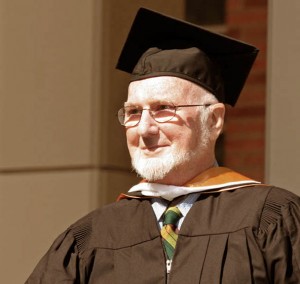Jorge Preloran Argentina. Jorge Preloran accepting the International Cinema Artist award from the UCLA School of Theater, Film and Television in 2008. Photograph by Juan Tallo. Image courtesy of the Human Studies Film Archives.
The Ransom Center recently received a grant from the Tinker Foundation, based in New York City, to restore and make accessible four films by Jorge Prelorán. The series, “The Argentine Gaucho Today,” resides in the Edward Larocque Tinker collection at the Ransom Center.
Born to an Argentine father and Irish-American mother, Prelorán held both American and Argentine citizenship. He grew up in Buenos Aires, studied architecture and then film at the University of California, Los Angeles in 1961, began filming at the University of Tucumán, and moved to Los Angeles in 1976 to teach at UCLA until he retired in 1994. Prelorán died in 2009.
A cultural icon in Argentina, Prelorán donated his archive to the Human Studies Film Archives at the Smithsonian Institution in 2008. He is celebrated for having developed a cinematic genre known as ethnobiography.
What makes this grant special is that the Tinker Foundation provided the original grant to Prelorán to produce the films in 1961. “The Tinker Foundation has come full circle in that it supported the creation of the films, and now it is making certain that the films will continue to benefit students and scholars interested in documentary film well into the future,” said Steve Wilson, Curator of Film at the Ransom Center. “Not only will students and scholars be able to study the films at the Ransom Center, but through our collaborations with the Smithsonian Institution, they will also be available for exhibitions and dissemination via video, television, and the Internet,” he added.
Prelorán’s interest in documentary film production was fueled by work in Hollywood as an assistant director for documentary films and television. In 1961, he received an opportunity to further develop his documentary talents: a $35,000 grant from the Tinker Foundation to make a film on gauchos in Argentina. In an interview, Prelorán recalled, “With $8,000, a borrowed jeep, and seven hours of film, I set out with Horst Cemi, also a UCLA graduate, to discover my country, Argentina.”
The result was not one film, but a four-film series on the gauchos found in representative cattle raising areas.
Among his many honors, Prelorán received the Golden Astor award for life achievement at the Mar del Plata Film Festival in Argentina (2005) and was also declared a Distinguished Citizen by the City of Buenos Aires (2005). In 2008, Prelorán was awarded the International Cinema Artist award by the UCLA School of Theater, Film and Television. A feature-length Argentine documentary film on Prelorán’s life’s philosophy, Huellas y Memoria (Footsteps and Memory), was released in 2009.
Learn more about the Ransom Center’s film collections.
Royal Road Camino Real Cordoba Argentina | Promote your Page too
 2012 Bob Frassinetti Copyright Roberto Dario Frassinetti
2012 Bob Frassinetti Copyright Roberto Dario Frassinetti

 2012 Bob Frassinetti Copyright Roberto Dario Frassinetti
2012 Bob Frassinetti Copyright Roberto Dario Frassinetti
« previous
|
next »
Jorge Preloran accepting the International Cinema Artist
The Ransom Center film collection provides research opportunities for scholars working in history, music, popular culture, textual criticism, and film history and criticism. The collections include more than 10,000 scripts for film, television, and radio; more than 15,000 posters, lobby cards, and other advertising materials; and over a million photographs, including film stills, portrait and publicity photographs, set and location reference stills, makeup and wardrobe stills, and candid, behind-the-scenes photographs. Virtually all of the collections include correspondence, memos, production records, or business records. The bulk of the collection concerns mainstream Hollywood filmmaking from the silent era through the present day. Hollywood's Golden Age (1930-1950) is particularly well represented. Other archives relate to the Texas film industry, television, and radio.
More Information on Links
About Bob Frassinetti Art Collector and Antique Dealer
Art and Antiques in Argentina
The Buenos Aires Toy Museum
El Primer Museo de Juguete on line Argentino
Villa Tulumba Codroba Argentina
Bob Frassinetti on Face Book
About Bob Frassinetti Art Collector and Antique Dealer
Art and Antiques in Argentina
The Buenos Aires Toy Museum
El Primer Museo de Juguete on line Argentino
Villa Tulumba Codroba Argentina
Bob Frassinetti on Face Book


